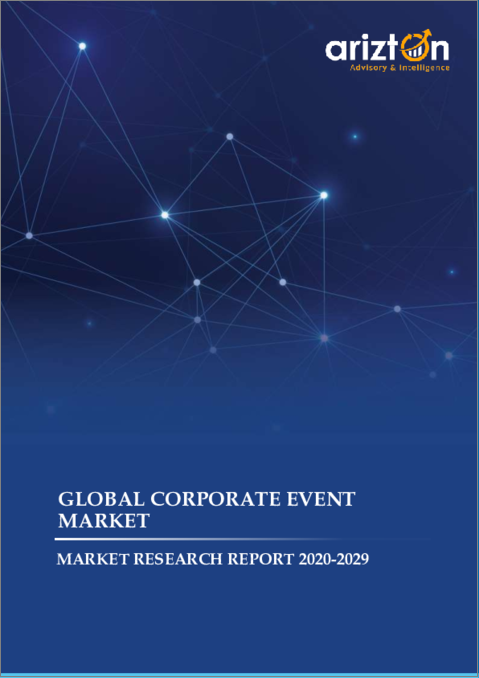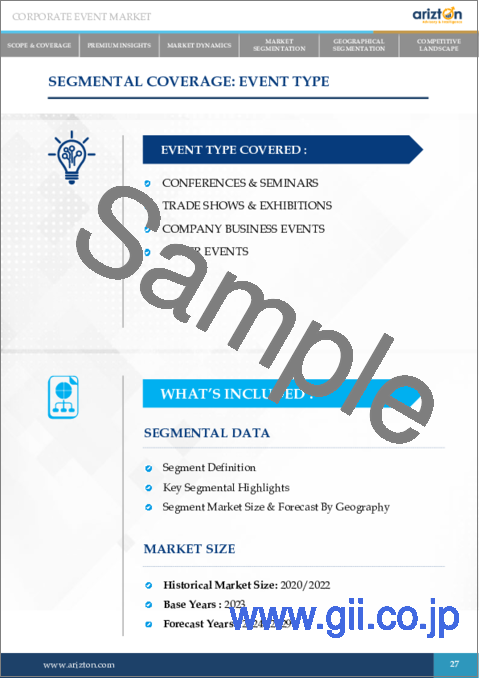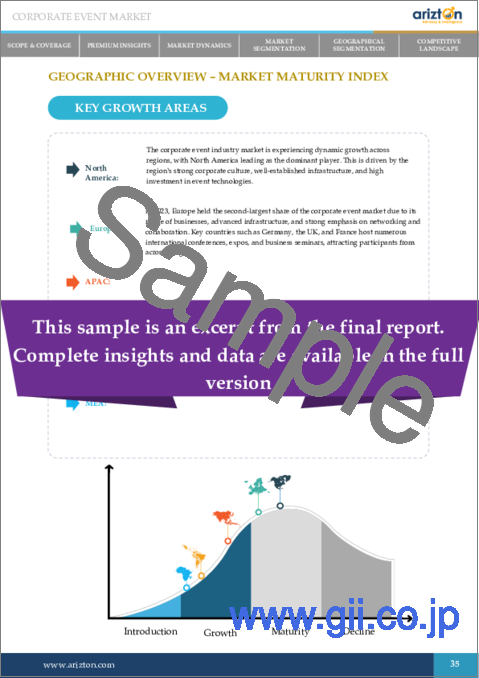|
|
市場調査レポート
商品コード
1641377
企業イベントの世界市場:2020年~2029年Global Corporate Event Market Research Report 2020-2029 |
||||||
|
|||||||
| 企業イベントの世界市場:2020年~2029年 |
|
出版日: 2025年01月21日
発行: Arizton Advisory & Intelligence
ページ情報: 英文 151 Pages
納期: 即納可能
|
全表示
- 概要
- 目次
世界の企業イベントの市場規模は、2023年から2029年にかけてCAGR 10.61%で成長すると予測されています。
市場成長の背景には、エクスペリエンシャル・マーケティングの重視、ネットワーキングの機会に対するニーズの高まり、ハイブリッド・イベントやバーチャル・イベントの増加傾向など、いくつかの要因があります。新技術の登場により、サービス・プロバイダーは業務の効率化を図り、参加者の体験を向上させ、イベント全体の効果を高めることができるようになっています。
企業イベント市場でも、テクノロジー主導のソリューションが急増し、イベントの企画・実施における効率と効果の向上が促進されています。2024年には、HopinやWhovaといったプラットフォームが人気を集め、参加者の登録からイベント後の分析まで、すべてを管理する包括的なツールを提供しています。さらに、企業のイベント産業分野では、持続可能性も重要な検討事項となってきています。環境問題への意識が高まる中、多くのイベントプランナーは、イベントを企業の社会的責任目標に沿わせるため、環境に優しい慣行を採用しています。
LinkedIn、Instagram、Facebook、Twitterなどのソーシャルメディア・プラットフォームは、話題を作り、知名度を上げ、企業イベントの出席を促進するための強力なチャンネルとなっています。また、インド、ブラジル、メキシコ、東南アジアなどの新興国では、これらの地域の企業が事業を拡大し、パートナーシップを育み、従業員のエンゲージメントを重視しているため、企業イベントの需要が急増しています。
世界の企業イベントの市場規模は2023年に3,250億米ドルとなり、急速な技術進歩、経済投資の増加、持続可能性の実践における著しい進歩とともに成長しています。この分野の需要の主な促進要因は、北米、欧州、アジア太平洋などの主要市場に集中しています。これらの地域は、新たな消費者の嗜好や市場力学に適応しながら、企業の革新と実行をリードしています。
地域別では、北米が2023年の企業イベントの市場シェア35%超で最大を占め、次いで欧州が続きます。アジア太平洋はイベント管理市場として最も急成長しています。
2023年は、見本市・展示会分野が最も急成長し、予測期間中のCAGRは11.02%となる見込みです。
当レポートでは、世界の企業イベント市場について調査し、市場の概要とともに、イベントタイプ別、イベント規模別、プラットフォーム別、業界別、地域別の動向、および市場に参入する企業のプロファイルなどを提供しています。
目次
第1章 範囲と対象範囲
第2章 チャンスのポケット
第3章 イントロダクション
第4章 市場機会と動向
第5章 市場促進要因
第6章 市場抑制要因
第7章 市場情勢
- ファイブフォース分析
第8章 イベントタイプ別(市場規模と予測:2020年~2029年)
第9章 イベント規模別(市場規模と予測:2020年~2029年)
第10章 プラットフォーム別(市場規模と予測:2020年~2029年)
第11章 業界別(市場規模と予測:2020年~2029年)
第12章 地域別(市場規模と予測:2020年~2029年)
- 北米
- 米国
- カナダ
- 欧州
- ドイツ
- 英国
- フランス
- イタリア
- スペイン
- アジア太平洋
- 中国
- 日本
- インド
- オーストラリア
- 韓国
- タイ
- マレーシア
- ラテンアメリカ
- ブラジル
- コロンビア
- メキシコ
- アルゼンチン
- 中東・アフリカ
- アラブ首長国連邦
- サウジアラビア
- 南アフリカ
- カタール
第13章 競合情勢
第14章 競争の概要
第15章 主要企業プロファイル
第16章 その他の有名企業プロファイル
第17章 レポートの概要
The global corporate event market is expected to grow at a CAGR of 10.61% from 2023 to 2029.
The market growth is underpinned by several factors, including the increasing emphasis on experiential marketing, the rising need for networking opportunities, and the growing trend of hybrid and virtual events. With the advent of new technologies, service providers have been able to streamline operations, improve attendee experience, and enhance overall event effectiveness.
The corporate event market has also witnessed a surge in technology-driven solutions, facilitating improved efficiency and effectiveness in planning and executing events. In 2024, platforms such as Hopin and Whova have gained traction, offering comprehensive tools for managing everything from attendee registration to post-event analytics. Furthermore, sustainability is also becoming a crucial consideration in the corporate event industry sector. With increasing awareness of environmental issues, many event planners are adopting eco-friendly practices to align their events with corporate social responsibility goals.
Social media platforms such as LinkedIn, Instagram, Facebook, and Twitter have become powerful channels for creating buzz, increasing visibility, and driving attendance for corporate events. Also, emerging economies such as India, Brazil, Mexico, and Southeast Asia are seeing a surge in demand for corporate events as companies in these regions expand their operations, foster partnerships, and focus on employee engagement.
KEY TAKEAWAYS
- The global corporate event market is valued at USD 325 billion in 2023, growing with rapid technological advances, increased economic investment, and significant strides in sustainability practices.
- The primary drivers of demand in this sector are concentrated in major markets such as North America, Europe, and APAC. These regions are leading the way in corporate innovation and execution, adapting to new consumer preferences and market dynamics.
- Geographically, North America accounted for the largest market for corporate events in 2023 with a market share of over 35%, followed by Europe. APAC is the fastest-growing market for event management.
- The event management market is segmented based on various factors, including the type of events, size of the event, platform of the event, and industry.
- In 2023, the trade shows & exhibition segment is expected to grow at the fastest rate, with a CAGR of 11.02% during the forecast period.
MARKET TRENDS
Technology utilization is certainly significant in the corporate event market through ticketing software, event applications, virtual reality, data analytics, information, and communication technologies. Also, in corporate event management AI plays a pivoted role in virtual and hybrid events as its chatbots provide immediate personal responses to the queries of the attendees, and ML algorithms are likely to forecast the attendee's behavior to justify planning decisions.
The hybrid event signifies a growing trend in the corporate event industry; these events combine physical and online elements. It has gained substantial momentum in recent years and is closely related to the market dynamics of corporate events, driving high demand for corporate events. Also, digital technology has also accelerated the adoption of virtual events as numerous organizations recognized the benefits of reaching an expansive and diverse audience by incorporating virtual factors into their events.
MARKET DRIVERS
The rapid increase in SMEs is significantly driving the demand for the corporate event market as these businesses prioritize events to foster growth, networking, and brand visibility in an increasingly competitive market. Also, the rapid adoption of digital technologies by small and medium-sized enterprises has opened new avenues for corporate event engagement, such as virtual and hybrid event formats that offer increased flexibility and reach.
Trade shows and expos have evolved into essential components of a company's marketing strategy, offering a unique chance to enhance brand visibility, generate leads, and establish a strong market presence. Furthermore, the surge in entrepreneurship, particularly within emerging markets, has fostered a vibrant environment for business seminars. As more individuals embark on starting their own startups or small businesses, there is an increasing demand for knowledge-sharing, mentorship, and skill-building opportunities.
INDUSTRY RESTRAINTS
High operational costs associated with corporate events create significant challenges for the industry, impacting profitability, budget management, investment choices, contractual obligations, and competition. The increasing expenses in areas such as venue rentals, catering, technology, and staffing have led to shrinking profit margins for event organizers. Moreover, the evolving landscape of corporate events has introduced a myriad of challenges for the industry, primarily driven by shifting attendee expectations that demand more engaging, personalized, and interactive experiences.
Global uncertainties have significantly hampered the demand for the corporate event market, creating an environment of unpredictability that affects both planning and attendance. Economic downturns, such as the recession fears looming over various regions, make companies more cautious about their spending, leading to budget cuts for non-essential activities such as corporate events.
SEGMENTATION INSIGHTS
INSIGHTS BY EVENT TYPE
The global corporate event market by event type is segmented into conferences & seminars, trade shows & exhibitions, company business events, and other events. In 2023, the conferences & seminars segment dominated the market and is estimated to maintain its dominance through the forecast period. This is attributed to the fact that conferences & seminars are events conducted in a format that creates a learning-by-doing atmosphere through experiments, discussion, and interaction among the attendees. Furthermore, the trade shows & exhibitions segment is expected to grow to the highest CAGR of around 11% during the forecast period, owing to the rising industry events to raise business profile and generate brand awareness. Moreover, the company business events segment holds a smaller market, but it remains essential for organizational growth. With businesses increasingly focusing on employee engagement, motivation, and alignment with corporate goals, company business events have become a standard practice for many firms.
Segmentation by Event Type
- Conferences & Seminars
- Trade Shows & Exhibitions
- Company Business Events
- Other Events
INSIGHTS BY EVENT SIZE
The mega & large scale event size holds the largest global corporate event market share as they offer economic benefits including new investments, business, sponsorships, and others. Major industry conferences like the Consumer Electronics Show (CES) and Mobile World Congress (MWC) exemplify large-scale events that draw international attention, showcasing cutting-edge innovations and facilitating networking opportunities among industry leaders. Furthermore, with the rising popularity of small-scale events, the need for more personalized and intimate experiences offered to participants has increased. The opportunity to network more effectively, exchange ideas, and create lasting relationships. The small & medium-scale segment is estimated to grow at the highest CAGR of 11.39% during the forecast period.
Segmentation by Event Size
- Mega & Large Scale
- Small & Medium Scale
INSIGHTS BY PLATFORM
The global corporate event market by platform is segmented into physical, virtual, and hybrid. In 2023, the physical events segment held the highest market share as they are the most conducted events owing to extensive methodologies and techniques to conduct physical events. Furthermore, virtual events have gained significant traction and represent a considerable share of the market. Their ability to reach a global audience, minimize costs, and provide real-time data analytics makes them an attractive option for companies looking to maximize engagement with minimal investment. Moreover, the hybrid segment is expected to grow at the highest CAGR of 11.05% during the forecast period as it has become increasingly popular over the last few years, owing to the ease of conducting and wider customer reach. The rise of hybrid events has been propelled by technological advances such as live streaming, VR, and AR, offering a seamless experience to both in-person and online attendees.
Segmentation by Platform
- Physical
- Virtual
- Hybrid
INSIGHTS BY INDUSTRY
The global corporate event market by industry is segmented into technology, automotive, healthcare & pharmaceutical, finance & banking, and other industries. In 2023, the technology segment dominated the market. The tech industry's high frequency of product launches, rapid innovation cycles, and emphasis on staying connected with clients, partners, and developers drives this segment's dominance. Furthermore, technology giants such as Microsoft and Google hosted high-profile conferences that brought together industry leaders, developers, and customers, emphasizing collaboration and innovation. These events often feature speeches, product launches, and interactive workshops, creating opportunities for networking and knowledge sharing.
The finance & banking sector holds a substantial share of the corporate event market, particularly due to the need for networking, regulatory compliance, and knowledge sharing. Furthermore, the healthcare & pharmaceutical sector is the fastest growing in the corporate event market, driven by the demand for medical education, research updates, product launches, and collaborations among healthcare professionals.
Segmentation by Industry
- Technology
- Automotive
- Healthcare & Pharmaceutical
- Finance & Banking
- Other Industries
GEOGRAPHICAL ANALYSIS
The global corporate event market is experiencing dynamic growth across regions, with North America leading as the dominant player. This is driven by the region's strong corporate culture, well-established infrastructure, and high investment in event technologies. Furthermore, in 2023, Europe held the second-largest share of the corporate event market due to its range of businesses, advanced infrastructure, and strong emphasis on networking and collaboration. Key countries such as Germany, the U.K., and France host numerous international conferences, expos, and business seminars, attracting participants from across the globe.
APAC is emerging as the fastest-growing region in the global corporate event market, fueled by rapid economic development, a burgeoning middle class, and a surge in SMEs. Countries such as China, India, Japan, and Singapore are becoming prominent hubs for corporate events, driven by increasing investments in technology, infrastructure, and a growing interest in entrepreneurship and innovation. Furthermore, Latin America, while smaller in market size, is steadily gaining momentum in the corporate event industry. Countries such as Brazil, Mexico, and Argentina are witnessing a rise in corporate activities, trade shows, and expos, driven by the growing number of startups and SMEs. Moreover, MEA, although the smallest in terms of the corporate event market share, is gradually making its mark in the corporate event landscape because of the growing interest in hosting international conferences, trade fairs, and exhibitions. Investments in infrastructure, tourism, and technological advances are gradually enhancing the corporate event market in both regions.
Segmentation by Geography
- North America
- US
- Canada
- Europe
- Germany
- UK
- France
- Italy
- Spain
- APAC
- China
- Japan
- India
- Australia
- South Korea
- Thailand
- Malaysia
- Latin America
- Brazil
- Colombia
- Mexico
- Argentina
- Middle East & Africa
- UAE
- Saudi Arabia
- South Africa
- Qatar
VENDOR LANDSCAPE
The global corporate event market is a dynamic and competitive industry that encompasses a wide range of services and solutions related to planning, organizing, and executing various types of events, from corporate meetings and conferences to weddings, trade shows, concerts, and more. This sector witnessed significant growth and transformation in recent years, driven by evolving consumer preferences, technological advances, and changes in the global business landscape. Vendors in this market strive to distinguish themselves through various strategies, strengths, and unique selling propositions.
Many companies focus on specific niches in the market, such as corporate events, trade shows, destination management, or incentive travel. These specialized firms often build deep expertise in their chosen areas, allowing them to deliver tailored solutions and cater to clients with specific needs. Furthermore, manufacturers are channeling significant investments into developing advanced platforms for virtual and hybrid events, incorporating features like AI-powered analytics, immersive VR/AR technologies, and seamless live-streaming options.
Key Company Profiles
- American Meetings
- Creative Group
- Freeman
- 360 Destination Group
Other Prominent Company Profiles
- American Express Global Business Travel
- Asia Pacific Events
- ATPI
- BCD Meetings & Events
- Clarion Events
- Dragonfly Agency
- Encore Creations Pvt. Ltd
- Entertaining Asia
- GES
- Hosts Global
- Informa
- Magma Event
- Maritz
- McVeigh Global Meetings and Events (MGME)
- penguins
- PRA Events
- Reed Exhibitions
- Riviera Events
- Imprint Events Group
- TCG Events
- The Special Event Company (DRPG)
- Vista Events
KEY QUESTIONS ANSWERED:
1. Who are the key players in the global corporate event market?
2. How big is the global corporate event market?
3. What are the significant trends in the corporate event industry?
4. Which region dominates the global corporate event market share?
5. What is the growth rate of the global corporate event market?
TABLE OF CONTENTS
1. Scope & Coverage
- 1.1. Market Definition
- 1.2. Inclusions
- 1.3. Exclusions
- 1.4. Market Estimation Caveats
- 1.5. Market Size & Forecast Periods
- 1.5.1. Historic Period: 2020-2022
- 1.5.2. Base Year: 2023
- 1.5.3. Forecast Period: 2024-2029
- 1.6. Market Size (2020-2029)
- 1.6.1. Revenue
- 1.7. Market Segments
- 1.8. Market Segmentation by Event Type
- 1.9. Market Segmentation by Event Size
- 1.10. Market Segmentation by Platform
- 1.11. Market Segmentation by Industry
2. Opportunity Pockets
3. Introduction
4. Market Opportunities & Trends
- 4.1. Rise in Virtual & Hybrid Events
- 4.2. Increasing Technological Innovations
- 4.3. Rising Use of Data Analytics for Personalization
5. Market Growth Enablers
- 5.1. Rapid Increase in Small & Medium Enterprises
- 5.2. Trade Shows & Expos
- 5.3. Growing Interest in Entrepreneurship and Business Seminars
6. Market Restraints
- 6.1. High Operational Cost Associated with Corporate Events
- 6.2. Changing Attendee Expectations
- 6.3. Global Uncertainties
7. Market Landscape
- 7.1. Five Forces Analysis
8. Event Type (Market Size & Forecast: 2020-2029)
- 8.1. Conferences & Seminars
- 8.2. Trade Show & Exhibitions
- 8.3. Company Business Events
- 8.4. Other Events
9. Event Size (Market Size & Forecast: 2020-2029)
- 9.1. Mega & Large-scale
- 9.2. Small & Medium-scale
10. Platform (Market Size & Forecast: 2020-2029)
- 10.1. Physical
- 10.2. Virtual
- 10.3. Hybrid
11. Industry (Market Size & Forecast: 2020-2029)
- 11.1. Technology
- 11.2. Finance & Banking
- 11.3. Healthcare & Pharmaceutical
- 11.4. Automotive
- 11.5. Other Industries
12. Geography (Market Size & Forecast: 2020-2029)
- 12.1. North America
- 12.1.1. US
- 12.1.2. Canada
- 12.2. Europe
- 12.2.1. Germany
- 12.2.2. UK
- 12.2.3. France
- 12.2.4. Italy
- 12.2.5. Spain
- 12.3. APAC
- 12.3.1. China
- 12.3.2. Japan
- 12.3.3. India
- 12.3.4. Australia
- 12.3.5. South Korea
- 12.3.6. Thailand
- 12.3.7. Malaysia
- 12.4. Latin America
- 12.4.1. Brazil
- 12.4.2. Colombia
- 12.4.3. Mexico
- 12.4.4. Argentina
- 12.5. Middle East & Africa
- 12.5.1. UAE
- 12.5.2. Saudi Arabia
- 12.5.3. South Africa
- 12.5.4. Qatar
13. Competitive Landscape
14. Competitive Overview
- 14.1. Key Developments
15. Key Company Profiles
16. Other Prominent Company Profiles
17. Report Summary
- 17.1. Key Takeaways
- 17.2. Strategic Recommendations






